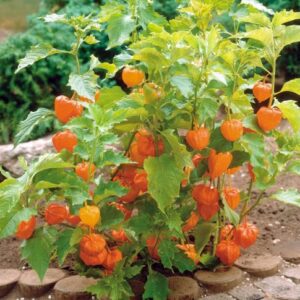Alkekengi – Physalis Peruviana

The alchechengi is a solanacea that originated in a vast range that goes from the Caucasus to Japan. Its berries, similar to small, slightly oily golden tomatoes, are hidden in floral calyxes with beautiful leaves that resemble tissue paper.
It is generally grown precisely for its aesthetic qualities, sold as a “Chinese lantern”. Like many other Solanaceae, it is a food rich in vitamins and interesting active ingredients: let’s find out which ones.
GROUND
Alkekengi is a rustic plant, easy to grow. It prefers sunny, clayey, draining soils and it is necessary that there is moderate but constant watering, especially in the summer months. It is necessary to water it two or three times a week, but as mentioned above, there must be no water stagnation, as this damages the plant. The alkekengi can be grown anywhere, it prefers a well-lit place but not exposed to direct sunlight, also protected from the wind.
FRUITS AND FLOWERS
The flowers are bell-shaped and originate from the axil of the leaves, have a reclining posture and are star-shaped. They have a length of about 2cm and are creamy white in color.
The fruits are bright red round berries with a diameter of about 1.5 cm, contained in a goblet of paper consistency that has a width of about 5cm, similar to a cone.
The berries are the only edible part of the plant; they contain rounded and flat seeds, with a diameter of about 2mm.
All the green parts of the plant are not edible, if ingested they can cause various gastrointestinal disorders, dizziness and nausea; the berries are edible only when they have reached maturity.
USE AND HEALTHCARE CONTENT
Alkekengi is eaten fresh like any other fruit but is also well known in its dried form. You can prepare sauces and jams and a delicacy is obtained if covered with chocolate.
The alchechengi is very decorative in fact just take out by turning the orange berry and keeping the thin peel similar to rice paper that covers the fruit. The resulting shape is very suggestive and can truly be an elegant touch to embellish fruit salads, desserts and sweets.
In phytotherapy it is mainly used against urinary retention, in case of nephritis, gout and uric acid stones.
PRUNING AND CULTURAL CARE
Alkekengi, being a perennial plant, should be pruned to a height of 10 / 15cm in autumn, covered with leaves or straw to keep the roots protected from frost. In spring, it will revive starting in mid-April with lush growth.
